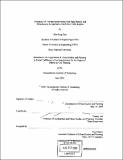Prototypes of transportation nodes with high density and mixed-use to be applied to Pearl River Delta Region
Author(s)
Han, Hye-Sung, 1971-
DownloadFull printable version (8.455Mb)
Other Contributors
Massachusetts Institute of Technology. Dept. of Urban Studies and Planning.
Advisor
Tunney Lee.
Terms of use
Metadata
Show full item recordAbstract
The main objective of this study is to develop a number of adaptable prototypes of transportation nodes with high-density and mixed-use to be applied to the Pearl River Delta Region in China and analyze its implications and potential impacts on the region, in conjunction with the planning studio work that focuses developing different development scenarios and growth strategies for this region. This study is based on the premise that the mass transit can consistently bring people to a concentrated area, increasing the likelihood that they will patronize business and perhaps live or work in the vicinity. While there are many ways that the influence of transit may be realized, it is difficult to isolate and account for all transitinduced changes. Correspondingly, this thesis addresses a deliberate response to transit that is concerted efforts to reconnect transit with urban form and land use. In addition, this thesis also examines cases of transportation nodes that attempted to link transit and urban development. From this study and the examination of other cases, it is concluded that efficient mass transit has positive impacts in urban realm; economic growth, better environment quality, more comfortable living conditions of people, reduced energy consumption, resource conservation and so on. Furthermore, transportation nodes are more efficient if they have high-density and mixed-use developments on top because mixed-use developments in the transportation nodes attract more people to the station and provide higher ridership which would increase fare box income. Equally important, as a rail system is very costly to build and also costly to operate and besides, few urban railway schemes are cost-effective in terms of the revenue generated by only passengers' fares, stations with developments on top would create revenue generated from land and air rights leases and also other forms of economic benefits that flow to the station properties. Hence, these wider benefits would allow government to subsidize investment in new railway projects, or to prop up existing lines.
Description
Thesis (M.C.P.)--Massachusetts Institute of Technology, Dept. of Urban Studies and Planning, 2000. Includes bibliographical references (p. 87-88).
Date issued
2000Department
Massachusetts Institute of Technology. Department of Urban Studies and PlanningPublisher
Massachusetts Institute of Technology
Keywords
Urban Studies and Planning.